小学英语介词的用法
小学英语介词短语(好)
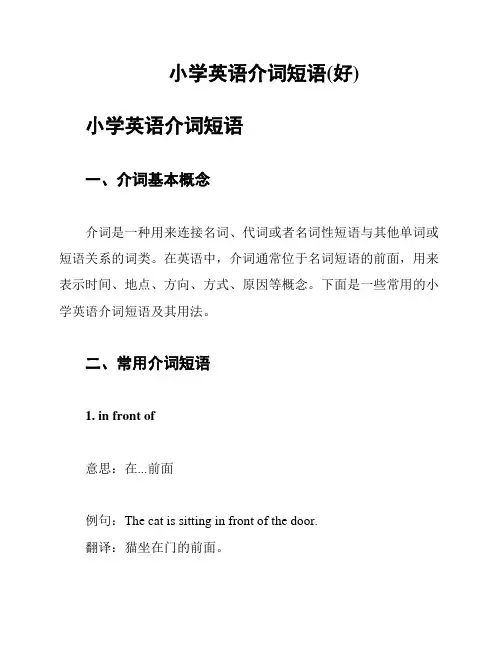
小学英语介词短语(好)小学英语介词短语一、介词基本概念介词是一种用来连接名词、代词或者名词性短语与其他单词或短语关系的词类。
在英语中,介词通常位于名词短语的前面,用来表示时间、地点、方向、方式、原因等概念。
下面是一些常用的小学英语介词短语及其用法。
二、常用介词短语1. in front of意思:在...前面例句:The cat is sitting in front of the door.翻译:猫坐在门的前面。
2. at school意思:在学校例句:I study English at school.翻译:我在学校学英语。
3. on the table意思:在桌子上例句:The book is on the table.翻译:书在桌子上。
4. under the tree意思:在树下例句:We had a picnic under the tree. 翻译:我们在树下野餐。
5. with a friend意思:和朋友在一起例句:I like playing soccer with a friend. 翻译:我喜欢和朋友一起踢足球。
6. by the beach意思:在海滩旁边例句:They built sandcastles by the beach. 翻译:他们在海滩旁边堆沙堡。
7. for breakfast意思:作为早餐例句:I had cereal for breakfast.翻译:我吃了谷物当早餐。
8. after school意思:放学后例句:Let's go to the park after school. 翻译:放学后我们去公园。
9. in the morning意思:在早晨例句:I like to jog in the morning.翻译:我喜欢早晨慢跑。
10. with a smile意思:带着微笑例句:She always greets everyone with a smile.翻译:她总是带着微笑向每个人打招呼。
小学英语语法-介词
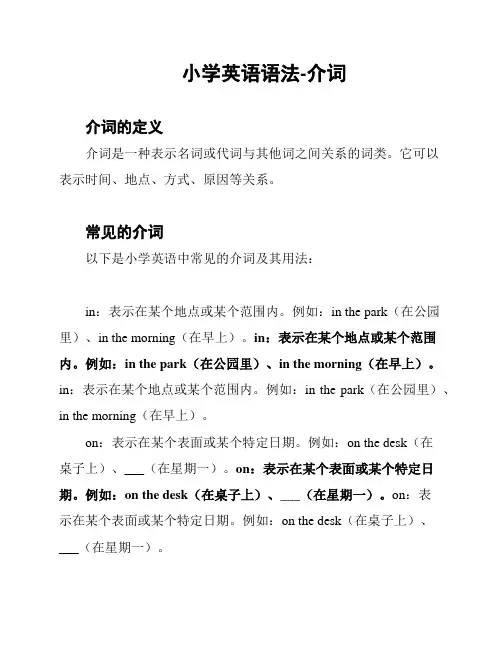
小学英语语法-介词介词的定义介词是一种表示名词或代词与其他词之间关系的词类。
它可以表示时间、地点、方式、原因等关系。
常见的介词以下是小学英语中常见的介词及其用法:in:表示在某个地点或某个范围内。
例如:in the park(在公园里)、in the morning(在早上)。
in:表示在某个地点或某个范围内。
例如:in the park(在公园里)、in the morning(在早上)。
in:表示在某个地点或某个范围内。
例如:in the park(在公园里)、in the morning(在早上)。
on:表示在某个表面或某个特定日期。
例如:on the desk(在桌子上)、___(在星期一)。
on:表示在某个表面或某个特定日期。
例如:on the desk(在桌子上)、___(在星期一)。
on:表示在某个表面或某个特定日期。
例如:on the desk(在桌子上)、___(在星期一)。
at:表示在具体的时间或某个地点。
例如:at 7 o'clock(在7点)、___(在学校)。
at:表示在具体的时间或某个地点。
例如:at 7 o'clock(在7点)、___(在学校)。
at:表示在具体的时间或某个地点。
例如:at 7 o'clock(在7点)、___(在学校)。
to:表示向某个地点或某个目标。
例如:go to the supermarket (去超市)。
to:表示向某个地点或某个目标。
例如:go to the supermarket(去超市)。
to:表示向某个地点或某个目标。
例如:go to the supermarket(去超市)。
from:表示从某个地点或某个时间开始。
例如:___(从星期一到星期五)。
from:表示从某个地点或某个时间开始。
例如:___(从星期一到星期五)。
from:表示从某个地点或某个时间开始。
例如:___(从星期一到星期五)。
by:表示通过某种方式或某个工具。
小学英语介词用法总结
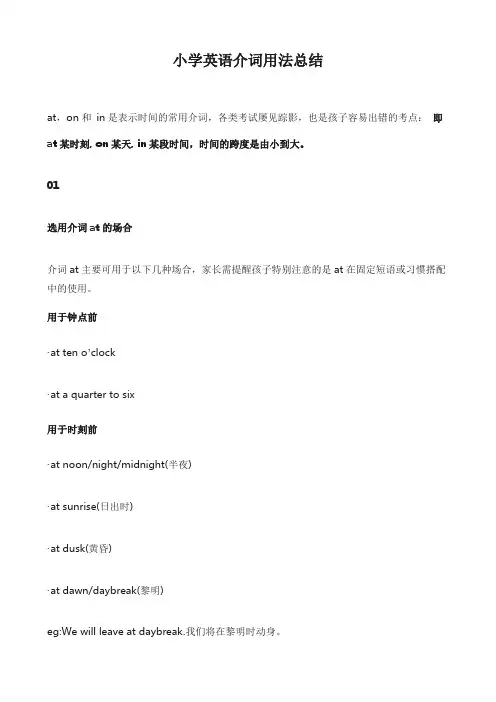
小学英语介词用法总结at,on和in是表示时间的常用介词,各类考试屡见踪影,也是孩子容易出错的考点:即at某时刻, on某天, in某段时间,时间的跨度是由小到大。
01选用介词at的场合介词at主要可用于以下几种场合,家长需提醒孩子特别注意的是at在固定短语或习惯搭配中的使用。
用于钟点前·at ten o’clock·at a quarter to six用于时刻前·at noon/night/midnight(半夜)·at sunrise(日出时)·at dusk(黄昏)·at dawn/daybreak(黎明)eg:We will leave at daybreak.我们将在黎明时动身。
用于表示进餐时间。
如:·at breakfast/lunch/supper(在早餐时/午餐时/晚餐时) eg:He drinks tea at breakfast.他在早餐时饮茶。
用于表示年龄时。
如:·at 14(= at the age of14在14岁)eg: He left home at the age of 16.他十六岁离开了家。
用于一些固定短语或习惯搭配中。
如:·at Christmas·at New Year·at Thanksgiving (感恩节)·at the beginning/end of last month·at the moment/ at that time·at this time of day·at a bad time of year·at first (起初)·at last (终于)02选用介词on的场合用于星期、日期(包括该天的各部分)前·on Sundays/weekdays·on Monday morning / afternoon / eveningeg:I'm flying home on Sunday afternoon. 我星期四下午乘飞机回家。
小学英语常用介词用法
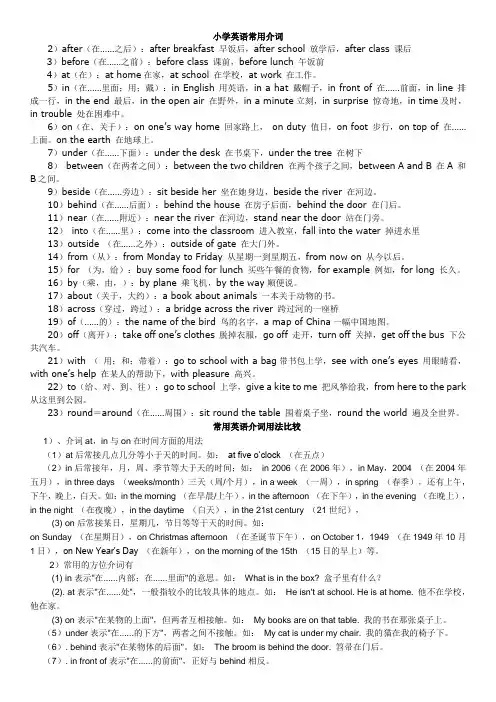
小学英语常用介词2)after(在……之后):after breakfast 早饭后,after school 放学后,after class 课后3)before(在……之前):before class 课前,before lunch 午饭前4)at(在):at home在家,at school 在学校,at work 在工作。
5)in(在……里面;用;戴):in English 用英语,in a hat 戴帽子,in front of 在……前面,in line 排成一行,in the end 最后,in the open air 在野外,in a minute立刻,in surprise 惊奇地,in time及时,in trouble 处在困难中。
6)on(在、关于):on one’s way home 回家路上,on duty 值日,on foot 步行,on top of 在……上面。
on the earth 在地球上。
7)under(在……下面):under the desk 在书桌下,under the tree 在树下8)between(在两者之间):between the two children 在两个孩子之间,between A and B 在A 和B之间。
9)beside(在……旁边):sit beside her 坐在她身边,beside the river 在河边。
10)behind(在……后面):behind the house 在房子后面,behind the door 在门后。
11)near(在……附近):near the river 在河边,stand near the door 站在门旁。
12)into(在……里):come into the classroom 进入教室,fall into the water 掉进水里13)outside (在……之外):outside of gate 在大门外。
小学英语介词的用法总结
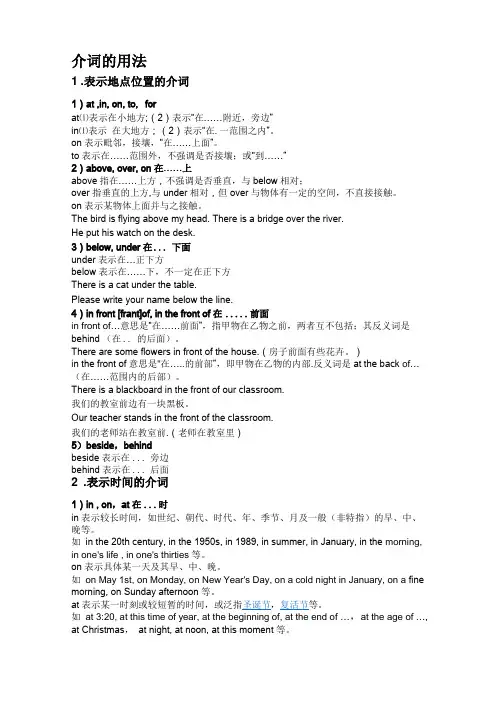
介词的用法1 .表示地点位置的介词1)at ,in, on, to, forat⑴表示在小地方;(2)表示“在……附近,旁边”in⑴表示在大地方;(2)表示“在.一范围之内”。
on表示毗邻,接壤,“在……上面”。
to表示在……范围外,不强调是否接壤;或“到……”2)above, over, on 在……上above指在……上方,不强调是否垂直,与below相对;over指垂直的上方,与under相对,但over与物体有一定的空间,不直接接触。
on表示某物体上面并与之接触。
The bird is flying above my head. There is a bridge over the river.He put his watch on the desk.3)below, under 在... 下面under表示在…正下方below表示在……下,不一定在正下方There is a cat under the table.Please write your name below the line.4)in front [frant]of, in the front of 在..... 前面in front of…意思是“在……前面”,指甲物在乙物之前,两者互不包括;其反义词是behind (在.. 的后面)。
There are some flowers in front of the house.(房子前面有些花卉。
)in the front of意思是"在…..的前部”,即甲物在乙物的内部.反义词是at the back of…(在……范围内的后部)。
There is a blackboard in the front of our classroom.我们的教室前边有一块黑板。
Our teacher stands in the front of the classroom.我们的老师站在教室前.(老师在教室里)5)beside,behindbeside表示在... 旁边behind表示在... 后面2 .表示时间的介词1)in , on,at 在... 时in表示较长时间,如世纪、朝代、时代、年、季节、月及一般(非特指)的早、中、晚等。
小学英语介词总结

小学英语介词总结介词是英语语法中重要的一部分,尤其对于小学生来说,理解和使用介词是掌握英语表达的关键。
以下是对小学英语介词的总结:1、关于时间的介词at:通常用于表示一个具体的时间点,例如 "at 7 o'clock"。
in:通常用于表示一个时间段,例如 "in the morning"。
on:用于表示在某一天或某一天的特定时间,例如 "on Monday"或"on my birthday"。
before:表示在某个时间之前,例如 "before dinner"。
after:表示在某个时间之后,例如 "after school"。
2、关于位置的介词in:用于表示在一个封闭的空间内,例如 "in the box"。
on:用于表示在一个平面上,例如 "on the table"。
under:表示在某物的正下方,例如 "under the table"。
above:表示在某物的上方,但是不一定是正上方,例如 "above the table"。
beside:表示在某物的旁边,例如 "beside the book"。
3、关于方向的介词to:用于表示朝向某个方向或地点,例如 "go to school"。
from:用于表示从一个地方或位置到另一个地方或位置,例如 "come from school"。
towards:表示朝向某个方向或地点,但是不一定到达那里,例如"walk towards the park"。
4、关于原因的介词because:用于表示原因或理由,例如 "I am late because I missed the bus"。
(完整版)小学英语常用介词及用法
常见介词及用法(一)表示时间的介词1.英语里最常见的时间介词有:at, in, on, before, after和from。
2.at , in和on这三个词都表示时间。
✧at主要指具体的钟点:at half past eight 在八点半✧in一般指某一段时间:in January 在一月份✧on指具体在某一天:on Monday 在星期一3.before和after表示时间的先后顺序。
✧before表示“在……之前”。
You should wash your hands before eating. 吃饭前你应该洗手。
✧after表示“在……之后”。
They often play basketball after dinner. 他们放学后经常打篮球。
4.from作时间介词含有“从……开始”的意思,常和to连用,组成“from…to…”的结构,表示“从……到……”的意思。
We go to school from Monday to Friday. 我们从周一到周五上学。
(二)表示方位的介词,也就是表示位置和地点的介词。
1.小学阶段常见的方位介词有:on, in, at, under, over, above, below, about,around, between等。
2.on, over和above这三个词都有“在……上面”的意思,但它们所表示的方位还是有些不同。
✧on表示两个物体的表面相互接触。
如:There is a book on the desk. 桌上有一本书。
The boy is sleeping on the desk. 那个孩子睡在地上。
✧over表示“在……的正上方”,两个物体表面没有接触。
如:There is a light bulb over my head. 在我头顶上有一个灯泡。
✧above表示两个物体中一个在另一个的上方,如:The plane is flying above the clouds. 飞机上云层上飞行。
小学英语常用介词用法
小学英语常用介词用法在学习英语的过程中,掌握介词的正确用法是非常重要的。
介词是连接词与词之间关系的一种词类,它能够表示时间、地点、方式、原因等等。
在小学英语中,常用的介词有很多,下面将为大家介绍一些常用的介词及其用法。
1. in介词"in"用于表示在某个范围内或在某个具体的位置上。
例如:- I live in a house.- There is a book in the bag.2. on介词"on"用于表示在某个表面上。
例如:- The cup is on the table.- The picture is on the wall.3. at介词"at"用于表示在某个点、位置或地方。
例如:- He is waiting at the bus stop.- We will meet at the park.4. by介词"by"用于表示通过某种方式或手段。
例如:- I go to school by bus.- They communicate by email.5. for介词"for"用于表示目的、原因或表示给予的对象。
例如:- This gift is for you.- I study hard for good grades.6. with介词"with"用于表示陪伴或伴随的状态。
例如:- She went to the park with her friends.- He plays basketball with his brother.7. to介词"to"用于表示目的、方向、接触等。
例如:- I go to school every day.- She gives a present to her teacher.8. from介词"from"用于表示出发地、来源或起点。
完整版)小学英语各种介词的用法
完整版)小学英语各种介词的用法XXX are n words used to XXX。
They cannot stand alone asa XXX noun。
pronoun。
or other word that ns as a noun。
phrase。
or XXX and its object form a nal phrase。
which XXX。
predicate。
complement。
or object of the XXX。
place。
manner。
reason。
XXX.XXX are one of the most active parts of XXX。
whichXXX+who/which" structure。
"that" cannot replace "who/which"。
For example。
"She is a good student from who we should learn."The following are some XXX:1.ns indicating place or n:a) "at," "in," "on," "to," and "for" can be used to XXX.b) "at" is used to indicate a small place or nearby n。
while "in" is used to XXX.c) "on" is used to indicate adjacency or contact with a surface.d) "to" is used to XXX of a range or "to" a n.2.ns indicating n:a) "above," "over," and "on" are used to indicate something is located on a surface or above it.b) "above" implies a n that is not necessarily vertical。
小学英语介词的用法及专项练习
小学英语介词的用法及专项练习介词的定义和作用介词是英语中一类重要的词性,用于连接名词、代词、动词或者其他介词与其他成分之间的关系。
介词可以表达方向、位置、原因、时间等等。
常见的英语介词有:in, on, at, for, with, by, from, to, over, under 等。
介词的用法1. 表示地点表示地点- in: 在某个区域或范围内- The cat is in the box.(猫在盒子里。
)- on: 在某个平面或表面上- The book is on the table.(书在桌子上。
)- at: 在某个具体的位置- She is waiting at the bus stop.(她在公交车站等待。
)2. 表示时间表示时间- at: 表示具体的时间点- The meeting starts at 9 o'clock.(会议在9点开始。
)- on: 表示某一天或日期- I have an appointment on Monday.(我在星期一有个约会。
)- in: 表示一段时间内- They will go on vacation in July.(他们将在七月份去度假。
)3. 表示原因表示原因- for: 表示目的或理由- We go to the park for a picnic.(我们去公园野餐。
)4. 表示方式表示方式- with: 表示伴随或使用- She writes with a pen.(她用钢笔写字。
)5. 表示运动表示运动- from...to: 表示由某个地方到另一个地方- He walked from home to the school.(他从家里走到学校。
)介词练请根据句子的意思,选择适当的介词填空。
1. The dog is __ the yard.(狗在院子里。
)2. My birthday is __ Sunday.(我的生日在星期天。
- 1、下载文档前请自行甄别文档内容的完整性,平台不提供额外的编辑、内容补充、找答案等附加服务。
- 2、"仅部分预览"的文档,不可在线预览部分如存在完整性等问题,可反馈申请退款(可完整预览的文档不适用该条件!)。
- 3、如文档侵犯您的权益,请联系客服反馈,我们会尽快为您处理(人工客服工作时间:9:00-18:30)。
小学四年级
介词preposition缩写prep.,又叫前置词,表示其后的名词或代词(或是相当于名词的其他短语或从句)与其他句子成分的关系。
介词是一种虚词,不能单独在句中作成分。
介词的用法
表示时间的(at 、on、in、at、before ,after、by、until、through、from、since、within)
(1)at:用于表示时刻,时间的某一点。
at noon在午时at night在夜间at present目前
(2)on:用于星期,某天,某一天的上午、下午、晚上(指具体的某一天时,一律用) on sunday在星期天on sunday morning 在星期天的上午
on march 8 在3月8日
(3)in:用于表示周、月、季节、年、泛指上午、下午、晚上。
in 1999 在1999年in november 在11月份
in summer 在夏季in the afternoon在下午
过……后(未来时间)
i think he will be back in an hour 。
我想他一小时后就会回来。
i heard that she would be back in a month.我听说她一个月后回来的。
(4)before:在……之前
wei hua got up before 7 o’clock this morning 。
今天早晨,魏华在7点之前起床了。
(5)after:在……之后
after that ,no noe should ever kill a seagull 。
从那时起,任何人不得捕杀海鸥。
(6)by:在……前(时间),截止(到)……
by the time i arrived ,she had already gone 。
在我到达之前,她已经走了。
(7)for:达……之久(表示过了多少时间),可以和一般现在时,过去时,将来时连用,但是经常和完成时连用。
florence often worked for twenty-four hours without rest 。
弗洛沦斯常常工作24小时而不休息。
(8)during:在……期间
during the lifetime of one man ,north america and europe will more further apart by nearly two metres 。
在一个人的一生期间,北美洲和欧洲由于漂移,其间的距离将要增加差不多两米。
(9)through:一直……(从开始到结束)
he ,who led the united states through these years ,was shot on april 14,1865 ,at a theater in washington
领导美国度过了这些年代的他,于1865年4月14日在美国华盛顿一家戏院里被人枪杀。
(10)from:从……起(时间)
the worders were made to work from 7 in the morning to 7 in the evening 。
工人们被迫从早7点工作到晚7点。
(11)since:自从……以来(表示从以前某时一直到现在仍在继续)
since that time ,my eyes had never been very good.从那时起,我的眼睛一直不是很好。
(12)within:不……超过的范围
he will arrive within an hour 。
他一小时内就人到。
口诀1:
年月周前要用in,日子前面却不行。
遇到几号要用on,上午下午又是in。
要说某日上下午,用on换in才能行。
午夜黄昏用at,黎明用它也不借。
at也在时分前,说“差”用to,说“过”要用part。
①早、午、晚要用in 例:
in the morning 在早上in the afternoon 在下午
in the evening 在晚上in the day 在白天
②黎明、午、夜、点与分用at例:
at dawn,at daybreak 在黎明时候at noon 在中午
at night 在夜间at midnight 在午夜at six o‘clock 在6点钟
at 7:30 (seven thirty) 在7点半at half past eleven 在11点半
at nine fifteen 在9点15分at ten thirty . 在上午10点30分
at the weekend 在周末
③年、月、年月、季节、周用in。
例;
in 1986 在1986年in 1927 在1927年in april 在四月
in march 在三月in december 1986 1986年12月in july l983 1983年7月
in spring 在春季in summer 在夏季in autumn 在秋季in winter 在冬季
in the fist week of this semester 这学期的第一周in the third week 在第三周。
